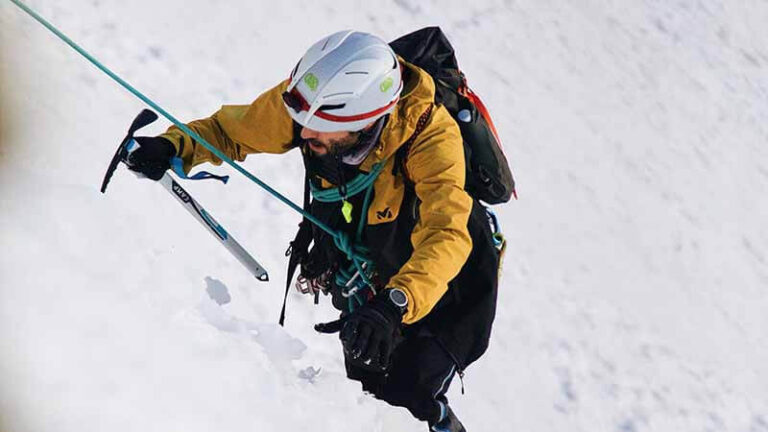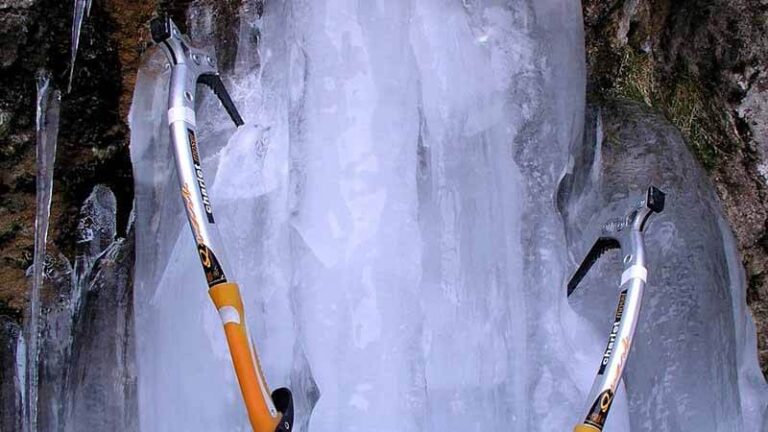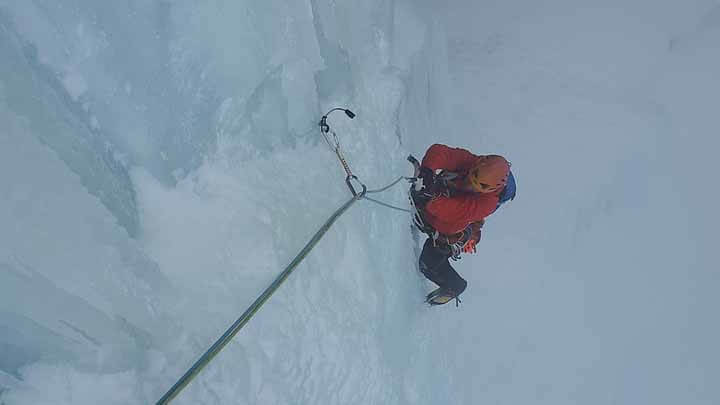How to Properly Maintain Your Ice Climbing Axes
The upkeep of ice climbing axes is critical for climbers’ safety and well-being. These specialist gear are essential for any ice climber since they provide stability and grip on difficult and frequently perilous ice terrain.
Regular maintenance keeps your ice climbing axes in top shape, lowering the chance of accidents and equipment malfunctions during climbs. An ice axe in good condition can mean the difference between a successful ascent and a potentially perilous situation.
Climbers may trust their axes to work dependably in the most demanding conditions of wear and damage that are addressed promptly.
Benefits of proper maintenance
Properly maintaining your ice climbing axes provides numerous benefits that go beyond safety. For starters, it considerably increases the lifespan of your expensive equipment, saving you money in the long run.
Ice axes are an investment, but with proper maintenance, they can last for years. Furthermore, maintaining your axes ensures that they operate optimally, giving you the control and precision required for successful climbs.
When your ice axes are in good shape, you’ll have a better grip and less fatigue, making your ice climbing experiences more pleasurable and successful. Furthermore, keeping your gear in good condition indicates a dedication to appropriate outdoor practices and environmental stewardship by reducing the need for frequent replacements and waste.
We will cover all aspects of maintaining ice climbing axes to ensure longevity and optimal performance in this detailed blog post. We’ll begin by addressing the significance of this maintenance and its immediate impact on climber safety. Following that, we’ll look at the real benefits of appropriate maintenance, stressing cost savings, improved performance, and environmental stewardship.
Following that, the post will walk you through the necessary tools and materials, ensuring you have all you need to begin the maintenance process. We’ll walk you through the process, beginning with pre-maintenance inspections and through to cleaning, sharpening, lubricating, and protecting your ice climbing axes. You’ll also learn how to inspect and maintain the leash and grip, as well as do a final inspection and testing of your equipment.
We’ll offer helpful hints on storage and transit to avoid damage, as well as a regular maintenance program. Finally, we’ll go over frequent problems and troubleshooting to assist you in dealing with unexpected hurdles.
You’ll have a thorough understanding of how to properly care for your ice climbing axes and ensure a safe and fun climbing experience by the end of this post.
Why Maintaining Your Ice Climbing Axes Is Crucial
Safety concerns
Because safety is vital in any adventurous activity, maintaining your ice climbing axes is critical. Ice climbing entails crossing steep and slippery terrain where even the smallest misstep can have serious effects.
Your axes are your major means of staying safe on the ice, providing stability, and preventing falls. Neglecting maintenance can lead to major failures like loose grips, dulled picks, or damaged leashes, all of which can cause accidents and injury.
Regular maintenance ensures that your equipment stays dependable, lowering the chance of unanticipated difficulties during climbs and, ultimately, contributing to your safety in this demanding activity.
Prolonging the lifespan of your equipment
Ice climbing axes are not only specialist instruments, but also expensive. They are built to withstand tough environments and provide long-term service. However, if these axes are not well maintained, they can deteriorate quickly, reducing their lifespan and prompting premature replacement.
You not only save money by taking the time to care for your equipment, but you also increase the useful life of your ice climbing axes. Axes that have been well-maintained will serve you dutifully for many seasons, making them a cost-effective choice in the long term.
Ensuring optimal performance
Your ability to ascend frozen surfaces effectively and securely is directly affected by the performance of your ice climbing axes. Axes that have not been properly maintained can have a lower grip, less precision, and overall poor performance. This can result in exasperating climbs, decreased control, and greater tiredness.
Regularly maintained axes, on the other hand, provide improved grip and maneuverability, letting you tackle difficult routes with confidence. Maintaining your equipment in good condition ensures that it operates at its optimum, providing you with the finest ice climbing experience possible.
Saving money in the long run
While ice climbing axes can be expensive at first, careful maintenance can result in significant long-term savings. Neglecting maintenance frequently leads to more frequent replacements and repairs, which can quickly add up. Investing time and effort in maintaining your axes, on the other hand, is a cost-effective technique that pays off over time.
You’ll save money on replacements and repairs, and your axes will last season after season. This not only saves you money, but also assures that you can enjoy ice climbing without the financial strain of acquiring new equipment on a regular basis. Maintenance is an investment in your safety as well as your cash.
Necessary Tools and Materials
Essential tools and materials for maintenance
It’s critical to have the necessary equipment and materials on hand to properly repair your ice climbing axes. The following are the essential items:
- Ice Axe Cleaning Brush: This is a specialist brush for removing ice and snow buildup from your axes.
- Sharpening Tool: This tool is essential for keeping your axe picks sharp and guaranteeing optimal performance.
- Lubricant: A good lubricant is necessary to keep moving parts like the axe head and leash attachments running smoothly.
- Clean Cloth: You’ll need a clean cloth to wipe down your axes after cleaning and lubricating them.
- Leatherman or Multi-Tool: These multi-purpose tools can assist with a variety of maintenance duties and simple repairs.
- Allen Wrenches: Various Allen wrench sizes are frequently required for tightening or modifying various components of your ice axes.
- Griptape: If your ice axe has a grip tape handle, have some available for replacements.
Purpose of each tool
- Ice Axe Cleaning Brush: With strong bristles, this specialized brush easily removes ice and snow buildup from the axe’s shaft, head, and other components without causing harm.
- Sharpening Tool: A sharpening tool, such as a file or sharpening stone, is used to keep your axe picks sharp. It aids in the restoration of the cutting edge, ensuring that your axes can successfully penetrate the ice.
- Lubricant: Lubricant, such as silicone-based grease or oil, is applied to moving elements including pivot points and leash attachments to minimize friction, prevent rust, and keep the components operating smoothly.
- A clean towel is required for wiping down your axes after cleaning and lubricating. It guarantees that there is no dirt or excess lubricant on the surface.
- Leatherman or Multi-Tool: These tools are useful for a variety of activities, including tightening loose bolts and making minor changes on the fly during climbs.
- Allen Wrenches: Different components of ice axes may contain Allen screws that need to be tightened or adjusted on occasion. Having a set of Allen wrenches on hand guarantees that you can properly address these concerns.
- Griptape: If your ice axes include grip tape on the handle, having extra grip tape allows you to replace worn or broken pieces while climbing, guaranteeing a strong grip.
Where to acquire these tools and materials
- Outdoor Equipment Retailers: Many outdoor equipment retailers, both physical and online, have a wide variety of ice climbing axe maintenance tools and materials. Look for stores that specialize in climbing and mountaineering equipment.
- Climbing Equipment Manufacturers: Some climbing equipment manufacturers produce their own repair kits and tools. Check the websites or catalogs of renowned climbing gear brands for specific ice axe care supplies.
- Local Climbing Communities: Members of climbing communities and clubs may often recommend where to find the necessary tools and materials locally. They may also arrange for equipment swaps or sales.
- Online Marketplaces: Websites including Amazon, REI, Backcountry, and specific climbing gear websites provide a wide range of maintenance tools and supplies, frequently with user evaluations to help you make a decision.
- Professional Climbing Shops: If you live near a climbing shop, they may stock a variety of ice climbing axe maintenance equipment and materials. The benefit of going to a physical business is that you can get personalized guidance from knowledgeable employees.
Pre-Maintenance Inspection
Visual inspection of the ice climbing axes
Before beginning the actual maintenance process, you should conduct a full visual assessment of your ice climbing axes. This phase entails thoroughly inspecting every element of your tool, from the axe head to the shaft and handle.
The goal is to find any evident symptoms of wear, damage, or anomalies that could jeopardize the safety and performance of your axes while climbing.
Pay particular attention to features such as scratches, dents, cracks, loose pieces, or bent shafts during this inspection. It’s also critical to inspect the overall cleanliness of your axes, as accumulated ice, grime, or debris might conceal underlying problems.
Identifying signs of wear and damage
Visual inspection is an important diagnostic technique for identifying indicators of wear and deterioration on your ice climbing axes. Picks that are dull or chipped, leash attachments that are frayed, or grip tape that is worn are all signs of wear. More serious damage may include cracks in the axe head or shaft, loose fasteners, or bent components.
By spotting these concerns early on, you may solve them in a timely manner, avoiding potential mishaps or equipment breakdowns during climbs. It’s critical to undertake this assessment methodically because even tiny indicators of wear or corrosion can quickly evolve into major issues when faced with the rigors of ice climbing.
Importance of addressing issues early
Addressing concerns discovered during the pre-maintenance inspection is critical for both safety and performance. When you handle problems as soon as they arise, you reduce the likelihood of having unanticipated challenges or failures while on the ice.
A little chip in a pick, for example, may not have a substantial impact on performance at first, but if left unchecked, it might deteriorate and jeopardize your ability to secure places on the ice.
Similarly, failing to tighten a loose bolt could result in the detachment of a vital component during a climb. Regular checks discover and correct these problems early, ensuring that your ice climbing axes stay reliable and safe to use.
Cleaning Your Ice Climbing Axes
Step-by-step guide to cleaning the axes
Removing ice and snow
Remove any accumulated ice and snow from your ice climbing axes as the first step in cleaning them. To gently loosen and brush away the frozen precipitation, use an ice axe cleaning brush or a stiff-bristle brush.
Take special care of the axe head, pick, and any gaps where ice can hide. Check for ice buildup on all surfaces, since it can impair axe function and make it more prone to corrosion.
Cleaning the shaft and head
After you’ve removed the ice and snow, clean the whole shaft and head of your ice axe. Add a mild detergent or climbing-specific cleaning solution to a pail or basin of lukewarm water. Allow the axe to soak for a few minutes to remove dirt and grime.
Then, gently scrub the surfaces with a soft cloth or sponge to remove any remaining debris or residue. Clean the axe head, handle, and any other accessible surfaces thoroughly.
Dealing with stubborn dirt and grime
In rare circumstances, you may come upon persistent filth or grime that necessitates extra care. Scrub away the residue with a soft-bristle brush or an old toothbrush in these places. Abrasive materials that could scratch or harm the axe’s finish should be avoided. Patience is essential for achieving a thorough and gentle cleaning process.
Use of appropriate cleaning agents
It is critical to use the proper cleaning solutions while cleaning your ice climbing axes in order to protect the integrity of your equipment. Mild detergents or climbing-specific cleaning solutions are excellent choices because they easily remove dirt and pollutants without harming the axe’s components.
Avoid using harsh chemicals or solvents since they might corrode or damage the metal components of your axe. Remember that preserving the longevity and functionality of your ice axes requires a gentle touch and the use of appropriate cleaning products.
Drying the axes properly
The final stage in the cleaning process is to properly dry your ice climbing axes. After cleaning, thoroughly rinse your axe with clean water to eliminate any leftover detergent or cleaning solution. Then, pat the axe dry with a clean, dry cloth, giving special attention to the axe head and any crevices where water may accumulate.
You can also leave your axes air dry in a well-ventilated area to guarantee proper drying, but avoid exposing them to direct sunshine, intense heat, or freezing temperatures. Proper drying prevents corrosion and keeps your ice axes ready for your next climb.
Sharpening the Picks
Step-by-step guide to sharpening the picks
Choosing the right sharpening tool
To begin, choose the proper sharpening tool for your ice climbing axes. Typically, a file or sharpening stone specialized for this purpose is required. Check the tool’s condition, as a dull or broken file will impede your sharpening attempts.
You could also want to consider purchasing a dedicated axe sharpening kit, which usually includes the essential tools and instructions.
Techniques for sharpening
Secure your ice axe in a sturdy position, either with a vise or by securely wedging it between your feet. Begin sharpening the pick by filing it in a single direction, moving the file or stone from the base to the tip.
Maintain consistent, equal pressure while filing, and avoid employing excessive force, which can result in uneven sharpness or pick damage. Repeat this process numerous times, verifying the sharpness of the pick every time.
Maintaining the correct angle
Maintaining the proper angle is one of the most important components in sharpening ice climbing axe picks. Experts generally propose a 90-degree angle between the pick’s edge and the sharpening tool. A consistent angle is essential for obtaining a sharp edge.
Some sharpening tools include guides or markings to assist you in maintaining the proper angle. To maintain balance, take your time and sharpen both sides of the pick evenly.
How often to sharpen your ice climbing axes
The frequency with which you sharpen your ice climbing axes is mostly determined by how frequently you use them and the type of ice you encounter. Many climbers sharpen their picks after every few expeditions or whenever they sense a drop in performance. If you climb on hard ice or mixed terrain on a regular basis, you may need to sharpen your picks more frequently.
Maintaining a keen edge is key for good ice climbing, so develop a sense of when your picks are losing their sharpness. Regular inspection and touch testing can assist you in determining when it is time to sharpen.
Signs that the picks need sharpening
There are various indicators that it’s time to sharpen your ice climbing axe picks. Among these indicators are:
- Loss of grip: If you notice your axes slipping or not securing positions as effectively as they used to, this is an indicator that the picks have lost their sharpness.
- Increased effort: If you’re using more force or energy than usual to make placements in the ice, it’s probably because the picks are no longer cutting into the ice effectively.
- Visual examination: Examine the options carefully. Sharpening is necessary if you observe rounded or dull edges, chipping, or apparent evidence of wear.
- Inconsistent performance: If one pick performs better than the other or if you have balance concerns while climbing, it could be due to uneven pick sharpness, which can be corrected by sharpening properly.
Lubricating and Protecting the Axes
Choosing the right lubricant
Choosing the right lubricant is essential for guaranteeing the smooth operation and longevity of your ice climbing axes. Ideally, you should use a lubricant designed for outdoor equipment and appropriate for the specific conditions of ice climbing.
A silicone-based grease or oil is frequently suggested since it effectively decreases friction and prevents rust while not collecting dirt and debris. Use caution when using general-purpose lubricants or oils that may not be suitable with the cold, damp, and icy circumstances that are common of ice climbing.
How to apply lubricant to the moving parts
Once you’ve selected the proper lubricant, it’s critical to apply it to the working parts of your ice climbing axes. Concentrate on axe head pivot points, leash attachments, and any other components that require movement.
Begin by applying a small amount of lubrication to the pivot points or joints, being careful not to overdo it because too much oil will attract dirt and ice.
Spread the lubricant evenly and work it into the moving parts with a clean cloth or your fingertips. Ensure that the lubricant reaches all surfaces that need to be protected and run more smoothly.
Protecting the axes from rust and corrosion
Preventing rust and corrosion is an important element of keeping your ice climbing axes in good condition. Ice climbing exposes your equipment to moisture and hard circumstances, making it prone to corrosion, particularly if the axes are metal.
Keep your axes dry whenever possible to prevent rust. After each climb, dry your axes carefully with a clean, dry cloth to remove any moisture.
Furthermore, as previously stated, the use of an appropriate lubricant creates a protective barrier against moisture and corrosion.
Inspect your axes on a regular basis for signs of rust, and if you find any, fix it immediately by cleaning and adding rust-inhibiting solutions.
Storing the axes properly
Proper storage of your ice climbing axes is critical for keeping them in good condition and preventing damage. When not in use, keep your axes dry and cold, away from direct sunlight.
Avoid storing them in moist or humid conditions, as this can hasten rust and corrosion. It is best to hang or store your axes horizontally to avoid bending or warping of the shafts.
If your axes have detachable leash attachments, consider removing them during storage to avoid putting undue strain on the components. Furthermore, keep your axes away from any chemicals or compounds that could potentially damage the materials.
Inspecting and Maintaining the Leash and Grip
Checking the condition of the leash
Inspecting the condition of your ice climbing axe leash is an important step in assuring climber safety. The leash is in charge of keeping the axe secure in your hand and preventing unintentional drops that could be harmful or result in lost gear. Examine the full length of the leash on a regular basis for signs of wear, fraying, or damage.
Pay close attention to areas surrounding connection points and any stitching, as these are common weak points. If you find any problems with the leash, you must solve them immediately to minimize any accidents when climbing.
Replacing damaged or worn leashes
If your ice axe leash becomes damaged, frayed, or no longer secure, you must replace it immediately. Continuing to use a faulty leash puts your equipment in danger of failure and offers a considerable safety risk. Many outdoor equipment stores sell replacement leashes made specifically for ice climbing axes.
When replacing the leash, make sure it’s suitable for your axe model and that it’s correctly fastened to the axe head and grip per the manufacturer’s directions. Before going on a climb, always double-check the leash’s security.
Cleaning and maintaining the grip
Your hands make touch with your ice climbing axe at the grip, providing control and stability. Cleaning and maintaining the grip on a regular basis is critical for a pleasant and secure grip while climbing. Wipe down the grip with a clean cloth or sponge moistened with tepid water to remove any dirt, sweat, or residue.
Avoid using abrasive materials or harsh chemicals that may damage the surface of the grip. After cleaning, make sure the grip is completely dry before reusing it. Cleaning and maintaining the grip adds to a more comfortable and productive climbing experience.
Griptape replacement and care
If your ice axe has grip tape on the handle, it’s critical to keep an eye on its condition and repair it as needed. Griptape might wear down, become loose, or tear over time, reducing the quality of your grip. Remove the old grip tape carefully, wipe any adhesive residue, then apply fresh grip tape evenly and firmly.
Griptape replacement kits are usually available, or you can buy grip tape made specifically for ice climbing axes. In order to maintain a solid and pleasant grip during climbs, evaluate the grip tape on a regular basis for signs of wear or damage and rectify any concerns as soon as possible.
Final Inspection and Testing
Reassembling the ice climbing axes
Following completion of the maintenance duties on your ice climbing axes, the following step is to properly reassemble them. If you dismantle any components when cleaning, sharpening, or lubricating, be sure that all parts are securely and accurately reassembled.
Pay strict attention to minutiae like tightening nuts or screws to the manufacturer’s torque settings. Reassembly is critical to ensuring the safety and functionality of your ice axes when climbing.
Final visual inspection
Perform a final visual inspection on your ice climbing axes before putting them to use. Examine the whole length of the axes, from head to grip, to check that all maintenance activities were satisfactorily done.
Look for evidence of damage, wear, or loose components that were missed during earlier examinations. A comprehensive visual inspection detects any potential problems that could jeopardize your safety or the function of your axes while climbing.
Ensuring all moving parts function smoothly
Check that all moving parts of your ice climbing axes work smoothly as part of the final check. This involves inspecting the pivot points of the axe head, leash attachments, and any other moving parts.
Apply a gentle force to these pieces to ensure they move freely and that the lubricant is equally distributed. Any stiffness or sticking should be addressed as it may signal the need for more lubrication or modifications.
Basic functionality tests
Perform basic operational checks on your ice climbing axes to complete the final inspection and testing process. This entails mimicking your climb movements to check that your equipment is in good functioning order.
Check the grip to make sure it’s secure and comfortable. Plunge the pick into a suitable surface to ensure it penetrates efficiently. Gently swing the axes to check for balance and simplicity of use. These tests ensure that your axes will operate as intended during your next ice climbing experience.
Storage and Transportation Tips
How to store ice climbing axes between climbs
It is critical to store your ice climbing axes properly between climbs in order to keep them in good shape and ready for usage. When not in use, keep your axes cold, dry, and well-ventilated.
Avoid exposing them to direct sunlight or harsh temperatures, which can hasten wear and damage. To avoid bending or warping the shafts, hang your axes or store them horizontally.
If your axes have detachable leash attachments, consider removing them during storage to avoid putting undue strain on the components. It is also critical to keep your axes clean and dry before storing them, as moisture can cause rust and corrosion over time. By following these storage guidelines, you can extend the life of your ice climbing axes and maintain them in excellent shape.
Transportation considerations to prevent damage
It is critical to transport ice climbing axes safely to avoid damage during transport. Consider the following transportation suggestions when you travel to your climbing destination:
- Use a specialized gear bag: Invest in a high-quality ice climbing gear bag. These backpacks frequently include sections or sleeves to keep your axes and other tools from rubbing against one another, preventing scratches and damage.
- Wrap the picks: To avoid inadvertent damage or harm, cover the picks with protective caps or guards during shipping. These are often composed of rubber or plastic and are intended to protect the sharp edges.
- Store your ice climbing axes safely in your vehicle: If you’re transporting your gear by car, make sure your ice climbing axes are securely stored to prevent them from shifting or bouncing about during the ride. To keep them in place, use gear loops, carabiners, or other appropriate storage techniques.
- Avoid stacking heavy goods on top: Avoid stacking heavy items on top of your ice axes when packing your gear in a car or backpack, as this can result in bent or damaged shafts.
- Think about travel cases for air travel: If you’re traveling to your ice climbing destination, find out what the airline’s policies are for transporting ice climbing gear. To protect their axes from probable rough handling, some climbers use hard-shell cases or padded bags meant for plane travel.
- Check local regulations: When going abroad or to various regions, be aware of any unique regulations or limits governing ice climbing equipment shipping. Learn about customs requirements and standards for carrying sharp objects.
By taking these transportation issues into account, you’ll ensure that your ice climbing axes arrive intact and ready to use, allowing you to concentrate on the climbing adventure ahead.
Regular Maintenance Schedule
Creating a maintenance routine
A regular maintenance plan for your ice climbing axes is essential for ensuring their longevity and best performance. Set up particular periods or intervals for examining, cleaning, sharpening, lubricating, and maintaining your axes to build a maintenance regimen.
Because consistency is essential, it’s a good idea to coordinate your maintenance routine with your climbing schedule. You could, for example, elect to do maintenance duties after each climbing session or at the start of each climbing season. Making a schedule ensures that you don’t forget important duties and that your axes are always in great shape when you need them.
Frequency of maintenance tasks
The regularity with which you execute ice climbing axe maintenance activities might vary based on factors such as how frequently you climb, the type of terrain you encounter, and the conditions you face. There are, nevertheless, some general guidelines to follow:
- Visual inspections: Before and after each climb, perform a visual examination to identify any immediate problems. After several climbs or at the start and end of each season, a more comprehensive examination, including cleaning and lubricating, can be undertaken.
- Cleaning: After each climb, clean your axes to eliminate ice, snow, dirt, and dampness. A more thorough cleaning, including the removal of persistent filth, can be performed on a regular basis, such as every few climbs or as needed.
- Sharpening: As needed, sharpen your axe picks. The frequency with which you sharpen your picks is determined by elements such as the type of ice you climb and the quality of the picks. Sharpening every few climbs or at the start of the season is sufficient for many climbers.
- Lubrication: As needed, lubricate the working parts of your axes. When you observe any stiffness or resistance in the pivot points or leash attachments, do this. Additionally, reapply lubrication after extended use or if your axes have been exposed to harsh weather.
- Documentation: Maintain a log of your maintenance operations, including the date, tasks completed, and any issues detected. This documentation can be used to track the state of your axes over time and as a guide for future repair.
Importance of documentation
Keeping track of your ice climbing axe maintenance activities is an often-overlooked but important activity. Documentation has various advantages:
- Maintaining a maintenance history: Documenting when you completed maintenance tasks and what you addressed allows you to follow the history of the state of your axes. This historical data can be useful for spotting wear and damage patterns or trends.
- Future maintenance scheduling: By keeping track of maintenance dates and tasks, you can simply plan future maintenance based on your climbing frequency and the individual demands of your equipment.
- Warranty and resale value: Some manufacturers and buyers may value evidence of good maintenance, which can improve warranty coverage and potentially increase the resale value of your instrument.
- Accountability and safety: Keeping a maintenance journal ensures that you are accountable for your equipment’s care. It also contributes to safety by assisting you in detecting any flaws that may have gone unnoticed.
Troubleshooting Common Issues
Addressing common problems with ice climbing axes
Ice climbing axes, like any other outdoor equipment, can develop typical issues that necessitate troubleshooting. Here are some of the most common problems and how to solve them:
- Dull Picks: Sharpen your picks if you discover that they have become dull and are no longer successfully penetrating the ice. To restore their sharpness, use the sharpening processes described in your maintenance program.
- Loose Bolts, Screws, or Other Components: Loose bolts, screws, or other components might jeopardize the stability and safety of your axis. During your pre-maintenance inspections, look for loose parts and tighten them to the manufacturer’s recommended torque settings.
- Leash Wear: Leashes can become frayed or damaged over time. Inspect your leash on a regular basis and replace it as soon as you discover any symptoms of wear or compromise.
- Corrosion: If you see any rust or corrosion on your axes, clean the damaged areas and use rust-inhibiting chemicals. To prevent further rusting, dry your axes after use and store them in a dry place.
- Griptape Problems: If the grip tape on your axe handle becomes old, torn, or broken, replace it with a new grip tape as directed by the manufacturer.
- Stiff Moving Parts: If you notice stiffness in your axes’ moving parts, such as pivot points or leash attachments, it could be due to dirt or a lack of lubrication. Clean the afflicted regions, apply lubrication, and make sure the movement is smooth.
When to seek professional help
While routine maintenance and troubleshooting can address many difficulties with ice climbing axes, there may come a moment when professional assistance is required. Here are some scenarios in which you should seek professional assistance:
- Major Damage: If your axes have sustained significant damage, such as a bent shaft, fractured head, or damaged components, it’s advisable to seek the assistance of an experienced climber or a reliable climbing gear repair service. Repairing such problems on your own may jeopardize the safety and integrity of your axes.
- Complex Repairs: Some repairs, such as sophisticated alterations, complex hardware replacements, or specific adjustments, may necessitate the skills of an ice climbing equipment expert.
- Uncertain Diagnosis: Seek professional help if you’re unsure about the cause of a condition or if many issues are hurting your life. They can perform a complete inspection and offer repairs or replacements as needed.
- Warranty Issues: If your ice climbing axes are still under warranty, you should contact the manufacturer or an authorized dealer for assistance. Attempting warranty-voiding self-repairs may not be in your best interests.
Conclusion
Finally, appropriate ice climbing axe maintenance is more than simply a matter of extending their lives; it’s a key step in assuring your safety and performance while scaling icy terrain. You may be confident that your equipment will be up to the difficulties of your ice-climbing excursions if you follow a regular maintenance regimen that includes inspections, cleaning, sharpening, lubrication, and grip care.
We’ve discussed the relevance of setting a maintenance schedule, the importance of paperwork, transportation considerations, and fixing typical problems. These methods help to extend the life of your ice climbing axes and improve your overall climbing experience.
Remember that ice climbing axes are more than simply tools; they are an extension of oneself in the harsh world of ice and snow. Their dependability is critical, and your dedication to their care assures that they will be ready to face the rigors of each rise.
So, while you prepare for your next ice climbing excursion, take the time to meticulously maintain your axes. Whether you’re seeking the excitement of new ascents or returning to old favorites, well-maintained ice climbing axes will be your trusty companions, propelling you upwards while keeping you secure and in control every step of the way.







